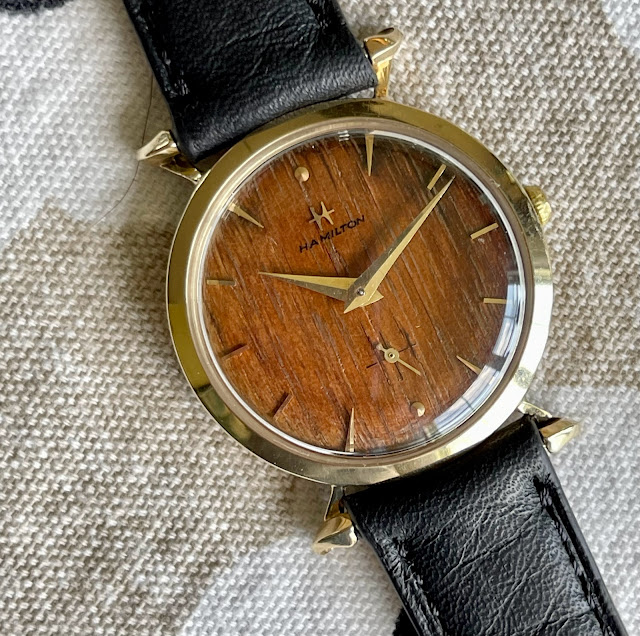Hamilton often introduced movement changes during a specific model's run that required a slightly different case design. These models were typically given a B designation. This became very common when the 14/0 sized 980, 982, and 982M movements were replaced by the 12/0 size 752, 753 and 754, respectively.
The another wave of B models came out in 1955 / 56 when the 770 movement was introduced. The 770 is a 12/0 size movement and would fit into a case for a 752, 753 or 754 without being a B model. However, there are a few examples where a 770 replaced the 8/0 sized 747 movement. That was the situation for the 1954 Parker when it became the 1956 Parker B.
You might wonder why Hamilton didn't just move to the shock jeweled 730 movement when it replaced the 747. I wonder that too - although the 770 was the pride of the Hamilton movement lineup.
The Parker B continued to be produced into 1961 so it's not a difficult model to find in the wild. The case is solid 10K gold though, so I'm sure more than a few have made their way to be melted when someone decided to turn a $350 watch into $100 cash.
My project Parker B came to me in well-loved condition. It's obviously had some miles put on it but it's not overall in terrible shape. The second hand is an obvious replacement and the crown is too.
The crown is called a "stone crown" and has a jewel of some sort embedded. Hamilton didn't use a lot of stone crowns on men's models but I have seen it before on new old stock models like the Liberty Coin.
With the bezel and crystal out of the way you can see the dial is pretty rough. This sort of dial rash is common when a watch loses it's crystal but this one was intact so maybe there is some sort of other environmental reason for the toning and scratches.
Up until this point I wasn't sure if I was dealing with a Parker or a Parker B. The Parker with the 747 movement is much less common. Once I got the movement out of the case it was immediately identifiable as a Parker B.
The inside of the case back is specifically formed to accommodate a 12/0 movement. The 747 is round and would have a differently-shaped cutout.
The crystal is due to be replaced and a quick measurement shows that a 29.2mm diameter high dome crystal will do nicely.
Looking in my stash of dials, I happen to have a Parker dial. The position of the dial feet are different on a Parker vs Parker B so I'll have to verify that it's the correct dial. Looking closely I noticed the number 2 was missing so if this is the correct style dial, I'll have to replace that marker.
It is the correct dial so now I need to find a proper number 2. A donor dial from a Nordon will do the trick. Markers are actually riveted on so you can carefully remove them from one dial and apply them to another as long as the markers are the same.
If you look closely at the number 2 you will see the two posts that will go into the holes in the dial. I usually apply a little UV glue to the back of the dial to make sure the rivets hold - then put the dial under a UV lamp.
There - good as new.
Everything is take apart and thoroughly cleaned and dried. Now I can reassemble everything with fresh lubricants in all the right places.
The reassembled movement is ticking away with good motion. Time to see what the timer thinks.
Running a smidgeon slow and the beat error is a little high. A slight tweak to the regulator will speed the balance up. I'll leave the beat error as is. My personal spec for beat error is 3.0ms. Above that I will try to reduce it. Below that the risk to the balance outweighs the benefit of a lower beat error.
Adjusting the beat error requires removing the balance from the balance cock and adjusting the position of the hairspring over and over until you get it right - each time is a roll of the dice that tempts doom.
Beat error represents how centered the balance is by swinging one side to the other. If the beat error is zero the balance swings equally one side to the other. A watch with a slightly higher beat error will stop sooner than a watch with no beat error. Whether a watch stops after 39 hours or 40 hours is pretty inconsequential when it comes to a vintage watch.
It doesn't take much adjusting to get the beat rate up to slightly fast at 14 sec/day. I'll leave it there as watches usually settle down after a while.
The finished watch now looks as good as it runs and it runs great. The metal bracelet is not original but it doesn't have spring-loaded ends and it looks good with the watch so I'll leave it as is.



























